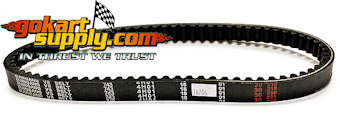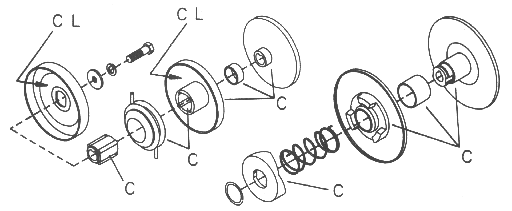
|
 |
|
ASW 14704 Go Kart Drive Belt. Genuine American Sportworks 14704 Belts. This is an Asymmetric Factory Belt that's flat on one side, angled on the other. 3/4" Top Width x 27.5" Long. Drive Belt for Comet 30 Series Torque Converters and Chinese Clones. (MARKED 725 ON BELT) Fits American Sportworks 4170 Fox Vector Go Karts and 208cc American Sportworks 5210 Marauder Go Karts. 725 Go Kart Belt - American Sportworks 14704 - American Landmaster 14704 Drive Belts. Same as Comet 203590A. Install with the flat side towards the engine.
Hammerhead Drive Belt 725 for Mudhead 208R and Mid-Size Go Karts. Replaces 9.110.018, 9100018080G0C0 and 9.100.018. Fits Hammerhead 80T and TrailMaster Mid XRX Go Karts with a 6.5hp engine. Ships from Louisiana, USA.
 | ||||||||||||||||
| ||||||||||||||||
Remove the bolt and any keepers from the end of the engine crankshaft and take the outer half of the clutch off. Clean the clutch. Install the belt with the flat side towards the engine, on the bronze bushing. Make sure both components are perfectly aligned, flat washers and shims are used as spacers. Do whatever it takes to align both sprockets so the chain will stay on, and both components so the side of the belt won't wear down prematurely and litter the system with belt debris. If you can install the belt without taking the clutch apart, the belt is too long.
If the system is 'eating belts' do not install a new belt until the problem has been corrected. A damaged belt is the symptom of another problem.
Inspect the driven pulley, the larger of the two components. Make sure that all six of the plastic insert buttons are in place. You can see them without taking the pulley apart. If any of the buttons come out, you'll see a hole where the button used to be. Don't run the system if any of the buttons are missing. Missing buttons will allow the driven pulley to open too far. The belt is then able to fall down into an area of the pulley where rivets are present. The rivets will destroy the belt. The insert buttons also keep the movable sheave from spinning, they reduce friction between the cam and the movable sheave and they prevent metal to metal contact thus acting as shock absorbers. The buttons play a very important role in the performance of a torque converter system. If you do have to replace the buttons, glue them into place with contact cement or a similar product.
If you need a longer or shorter Asymmetric Belt that's flat on the engine side, we have them. See the 3/4" Top Width, 30 Series Asymmetric Belts for Center Distances that range from 6-5/8" to 13-1/8". Some machines may require a different length belt if the original engine has been replaced, which usually changes the center distance, or if the 6" driven pulley has been replaced with a 7" driven pulley.
Maintenance will include proper cleaning and lubrication of the driver and driven. Inspect the torque converter on a regular basis for dirt, frayed belts and any other potential problem obvious from a visual inspection. Always service units before each season. Maximum service interval recommended is each 50 hours of operation.
Drive and driven pulleys should be parallel. Friction faces must be smooth and free of dirt, corrosion, oil or grease. Belt must be dry, straight, and free of cracks, breaks and uneven wear. Operating the vehicle in a dusty environment will require more frequent servicing.
Use Comet Dry Film Lubricant in all models of Torque Converters.
Indicators of a torque converter system requiring cleaning and lubrication are erratic or jerky engagement upon acceleration and a tendency to apparently "lock" into a particular speed (a second cause of jerky engagement is an excessively loose drive chain). If either one of these conditions exist service the unit immediately. Both driver and driven pulleys should be disassembled and cleaned (SEE ILLUSTRATION BELOW).

C = CLEAN - L = LUBRICATE
Visit the Trouble Shooting Page for more information on malfunctioning Torque Converters. Belts eventually wear over time but a damaged or torn up drive belt always indicates that a problem exists with the system. Only replace your drive belt after the problem has been corrected. Components must be clean, lubricated and perfectly aligned to function properly.
As the engine R.P.M. increases, the Driver pulley flanges continue to close together. This action, in turn, is squeezing the belt out to a larger diameter. This action is dependent on acceleration and lack of torque load on the Driven element, allowing it's pulley flanges to open thus creating a smaller driven unit diameter. If the torque load is increased this ratio is reversed instantly and smoothly to it's requirement. The ratios between low and high are infinite to meet all demands within it's realm of capabilities.
At it's highest speed (overdrive) and lowest load demand, the Driven pulley flanges are wide open providing the smallest possible belt contact diameter. The Drive unit pulley flanges, at this point, are closed to provide the largest possible belt contact diameter. The unique asymmetric arrangement of the belt and pulley angles allow the belt to exceed diameters possible with the standard "V" pulleys, thus overdrive.
![]()
Page Last Updated: 04/14/2025
© 1997-2025 Go Kart Supply, Inc
Terms and Conditions - Privacy Policy